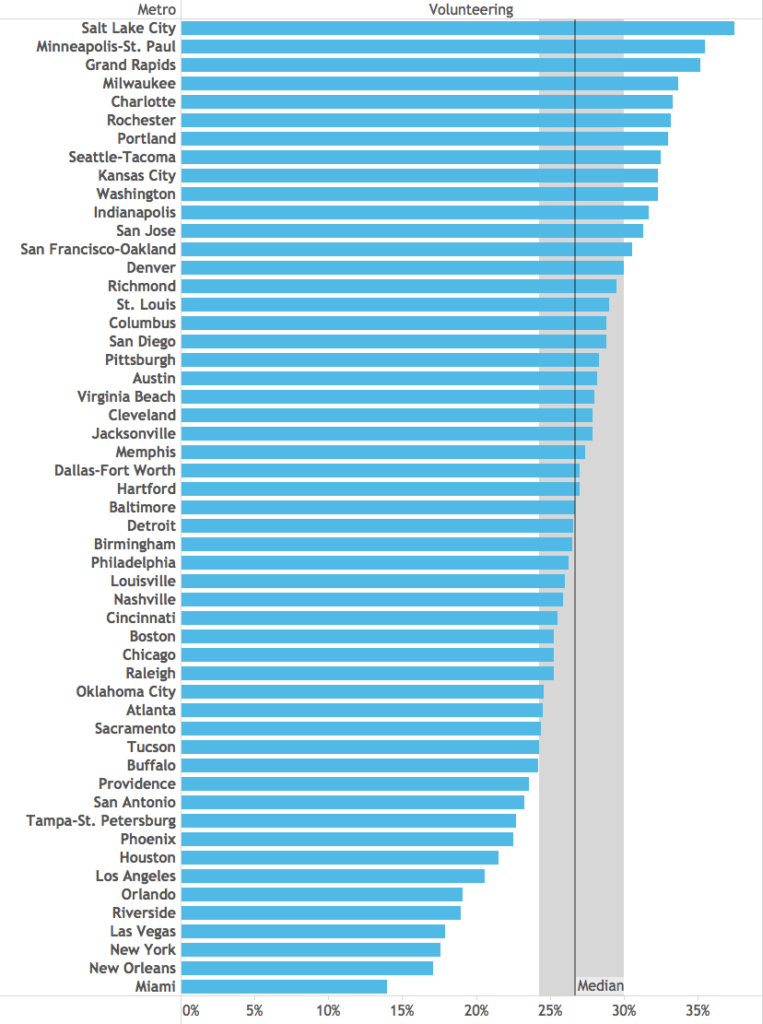Volunteering is one of the hallmarks of community; here are the cities with the highest rates of volunteerism
The decline of the civic commons, the extent to which American’s engage with one another in the public realm, especially across class lines, has been much remarked upon. Our report, Less in Common, explores the many dimensions along with the fabric of our connections to one another has become increasingly strained over several decades: we are less likely to socialize with neighbors, we travel in isolation, increasingly we recreate in private, rather than public space, and as a result, the strength of a shared public realm has deteriorated.
In his book Bowling Alone, Robert Putnam popularized the term “social capital.” Putnam also developed a clever series of statistics for measuring social capital. He looked at survey data about interpersonal trust (can most people be trusted?) as well as behavioral data (do people regularly visit neighbors, attend public meetings, belong to civic organizations?). Putnam’s measures try to capture the extent to which social interaction is underpinned by widely shared norms of openness and reciprocity.
As economist Brad DeLong explains,
. . . at some deep level human sociability is built on gift-exchange—I give you this, you give me that, and rough balance is achieved, but in some sense we both still owe each other and still are under some kind of mutual obligation to do things to further repay each other.
This sense of mutual obligation is important both to society, and the the effective function of markets. When we live in communities, places where most people have a strong sense of mutual obligation to look out for and take care of one another, social problems are lessened and economies run more smoothly.
It’s difficult to come up with a single, clear-cut indicator of social capital, so we and other researchers have ended up relying on a patchwork of different measures to judge the degree to which different cities exhibit high or low levels of civic interaction.
One of the most fundamental of these measures is volunteering. It’s long been a staple of American lore–since DeToqueville–that we regularly engage non-remunerated community activities.
Our data come from the Corporation for National and Community Service. It works with the Census Bureau to conduct a nationally representative survey exploring the degree to which Americans engage in a range of volunteer activities.
Across the nation’s largest metropolitan areas, about 27 percent of adults reported having volunteered in their local community the past year. The volunteering ethic is strongest in Salt Lake City and the Twin Cities of Minneapolis and St. Paul, where more than a third of adults volunteer. Conversely, volunteering is much lower than the national average in cities such as Miami, New Orleans, New York and Las Vegas.

This measure stands in stark contrast to our measure of “anti-social capital” the number of security guards per capita in each metropolitan area, which we wrote about earlier this year. Not surprisingly, cities that rank high in our measure of anti-social capital (Miami, New Orleans, and Las Vegas) are all in the “top five” for security guards per capita and in the bottom five for volunteering. Conversely, the cities with the fewest security guards per capita (Minneapolis, Portland, Grand Rapids and Rochester) are all in the top ten for volunteering.
While any ranking always implies that there are winners and losers, we interpret the variation we see here a bit more optimistically. These data imply that what happens in a metropolitan are can affect its degree of social capital. Fixing this problem from the top down may seem daunting, but improving social capital from the bottom up is something than can be done at the community level. No matter where you live, we’re sure there are opportunities for you to volunteer to help make your city a better place.
